|
  by
Dolane Larson by
Dolane Larson |
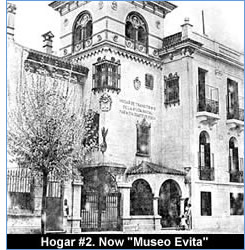 In 1948, the Fundación
opened three Hogares de Tránsito, temporary homes for people who
needed a place to live until their problems could be solved ( housing,
employment or medical attention). Preference was given to women with children. In 1948, the Fundación
opened three Hogares de Tránsito, temporary homes for people who
needed a place to live until their problems could be solved ( housing,
employment or medical attention). Preference was given to women with children.
Hogar #1,
at Carlos Calvo 102 , had space for 200 residents; Hogar #2, at Lafinur
2988 (now the headquarters of the Instituto Nacional de Investigaciones
Históricas Eva Perón and the location of the Museo Evita)
could house 280 residents and Hogar #3, at Austria 2561 could house 220.
These Hogares had once been mansions but were delapidated and needed extensive
renovation to be made habitable. Once renovated, they were luminous, comfortable
and inviting (Ferioli, 103) with spacious patios for the children to play
in, libraries, dining rooms with individual tables (so families could
eat together) and many other amenities. Evita sent the gifts she had received
in Europe: furniture, tapestries, fine paintings, rugs, porcelain and
other objects d’art. The most spacious of the three Hogares was
the one on Lafinur. Its small chapel was often used for baptisms and Evita’s
own niece and nephew, the twins Blanca and Juan Alvarez Rodriguez, were
baptised there. Evita was Blanca’s godmother and her sister Erminda
was Juan’s.
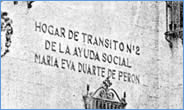 Residents
stayed for an average of about eight days or until the Fundación’s
social workers had solved their housing, employment, or medical problems.
When Evita inaugurated the Hogar #2 on Lafinur she promised that the Hogares
would provide “lodging with dignity, excellent food, spiritual,
material and moral support.” There would be classes for adults (sewing,
typing) and recreation for children (movies, crafts); “everything
they need” was to be given freely and for free. Residents
stayed for an average of about eight days or until the Fundación’s
social workers had solved their housing, employment, or medical problems.
When Evita inaugurated the Hogar #2 on Lafinur she promised that the Hogares
would provide “lodging with dignity, excellent food, spiritual,
material and moral support.” There would be classes for adults (sewing,
typing) and recreation for children (movies, crafts); “everything
they need” was to be given freely and for free.
The Hogares
were open to anyone who needed assistance. However, mothers -unwed, separated,
widowed, or abandoned- who had young children were moved to the top of
the list and meeting their needs was the first priority. The most common
problems the authorities had to solve were 1) unwed mother; 2) abandoned
mother; 3) families where the parents were not married; 4) families with
numerous children; 5) children with disabilities; 6) elderly people in
need of assistance; 7) invalids; 8) people with chronic illnesses; 9)
people needing medical treatment; 10) people in need of housing; 11) people
who needed employment; 12) people who had to move and needed a place to
stay; 13) immigrants. The Hogares provided all necessary services: finding
employment, providing transportation, helping people who needed hospitalization,
medicine or medical treatment; providing clothes and money; supplying
orthopedic apparatus.
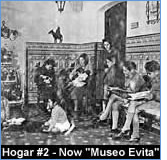 Each
person who stayed in the Hogares was able to choose his or her own clothes
and shoes from the “Clothing Section”. Children played in
luminous patios filled with playground equipmentand watched over by licensed
caregivers. Each Hogar had a modern, well-equiped clinic staffed by a
woman doctor and assistents. Classes were offered so that the women might
leave better equipped to earn a decent salary as a secretary or a seamstress
(or at least be able to sew for her family) and not have to be a maid
by default. Each
person who stayed in the Hogares was able to choose his or her own clothes
and shoes from the “Clothing Section”. Children played in
luminous patios filled with playground equipmentand watched over by licensed
caregivers. Each Hogar had a modern, well-equiped clinic staffed by a
woman doctor and assistents. Classes were offered so that the women might
leave better equipped to earn a decent salary as a secretary or a seamstress
(or at least be able to sew for her family) and not have to be a maid
by default.
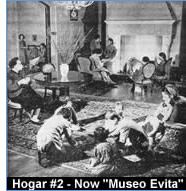 In 1954,
2280 people found shelter and help in the Hogares (Ferioli, 102). The
two most numerous groups were unwed mothers and people who needed medical
treatment. In 1954,
2280 people found shelter and help in the Hogares (Ferioli, 102). The
two most numerous groups were unwed mothers and people who needed medical
treatment.
After the 1955 military coup d’etat, the armed forces held private
auctions behind closed doors and the objects d’art went to the highest
bidders. The buildings were used for other purposes.
Bibliography
Ferioli,
Néstor. La Fundación Eva Perón / 1. Buenos
Aires:Centro Editor de América Latina, 1990.
Fraser, Nicholas
& Marysa Navarro. Evita: The Real Life of Eva Perón.
New York: W.W. Norton & Company, 1996.
Ortiz, Alicia
Dujovne. Eva Perón. New York: St. Martin’s Press,
1996.
Fundación
Eva Perón. Eva Perón and Her Social Work. Buenos
Aires: Subsecretaria de Informaciones, 1950.
Fundación
Eva Perón. Hogares de Tránsito. Buenos Aires: Subsecretaría
de Informaciones, no date.
La Nación
Argentina: Justa, Libre, Soberana. Buenos Aires: Ediciones Peuser,
1950.
|
 |
 ©
By Dolane Larson ©
By Dolane Larson |
When Evita was a little girl living in the small pampas town of Los Toldos, a very old man would sometimes come to the door of her house to ask for help. Evita called him "el señor Buen Día" because no matter how early or late he arrived, his greeting was always the same: "Good day, my little daughters!" Evita and her sister Erminda would run to ask their mother for a few coins to give him. After the death of their father, Doña Juana sewed far into the night to feed her children, but she always gave Evita something to help old "Mister Good Day."
In her biography, My Sister Evita, written twenty years after Evita's death, Erminda Duarte recalled those long ago days in the dusty pampas town and Mr. "Buen Día."
"He was one of those people who had suffered and been humiliated to the point where the only thing he had left was his humility. He seemed so forsaken! Yet his eyes had a luminous sweetness, as though he still had something in life to be grateful for.
"Nobody knew... where old Mr. Good Day lived, where he came from, who he was. Perhaps some thicket was his home, perhaps loneliness was his family. He was without doubt one of those people whom society expels from its midst, as though the person were no longer human.
"He was the first abandoned elderly person [Evita] came in contact with, and he awakened in [her] charity and a need to help."
On August 28, 1948, Eva Perón proclaimed the Decalogue of the Rights of Seniors, and on March 11, 1949, these rights (as well as the rights of workers), were incorporated into the revised 1949 Constitution. With the eyes of her heart, she must have seen old Mr. Buen Día as she announced that in the New Argentina, all seniors were endowed with ten rights:
1. The right to assistance and to protection
2. The right to housing
3. The right to food
4. The right to clothing
5. The right to health care
6. The right to spiritual care
7. The right to entertainment
8. The right to work
9. The right to tranquility, free from anguish and worry
10. The right to respect
On December 18, 1948, Evita made a speech affirming the rights of seniors:
"The drama of old age which lacks the most indispensable elements of life is a universal drama and bites with the same pain in all climates and under all latitudes. To solve the problem in one place is only to half solve it. No one has the right to ignore the voices of those who have worked all their lives and do not now have the possibility of spending their last days in tranquility but rather are condemned to a sorrowful, anguished, desperate old age; no society, no government has the right to ignore the morality of their cries."
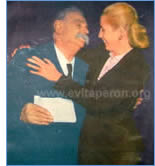 Social Security would not be available until 1950 when Congress, at the instigation of the Fundación Eva Perón, passed a law granting pensions to seniors. Evita did not want needy seniors to wait for help until the legislation passed. In 1948, she granted subsidies to those seniors whose needs had been verified by the social workers of the Fundación Eva Perón. Less than a year later, the Fundación began to give pensions to needy seniors over the age of sixty who did not qualify for social security. Many seniors came to Evita's office at the Ministerio de Trabajo y Previsión to apoly personally. On January 19, 1949, the newspaper Democracia told the story of a 113 year old Italian woman, born in Genova, who walked into the Ministry alone. When the surprised officials asked her why she hadn't taken a taxi, she replied, "And who would pay for it? A streetcar is fine, thank you very much!" Social Security would not be available until 1950 when Congress, at the instigation of the Fundación Eva Perón, passed a law granting pensions to seniors. Evita did not want needy seniors to wait for help until the legislation passed. In 1948, she granted subsidies to those seniors whose needs had been verified by the social workers of the Fundación Eva Perón. Less than a year later, the Fundación began to give pensions to needy seniors over the age of sixty who did not qualify for social security. Many seniors came to Evita's office at the Ministerio de Trabajo y Previsión to apoly personally. On January 19, 1949, the newspaper Democracia told the story of a 113 year old Italian woman, born in Genova, who walked into the Ministry alone. When the surprised officials asked her why she hadn't taken a taxi, she replied, "And who would pay for it? A streetcar is fine, thank you very much!"
In 1950, at the Colón Opera House, Evita awarded the first one thousand pensions to seniors, saying, "As President of the Fundación Eva Perón, I want to offer my homage to these senior citizens.... [T]his young woman reverently assures them that they can be confident that wherever Eva Perón is, there will also be a strong resolution to offer the descamisados her untiring service."
"In a United Nations special assembly, fifty-six nations expressed their admiration for the generosity and wisdom of the Decalogue and many of them adopted it as legislation in their own countries." (Celina Martinez Paiva and Maria Rosa Pizzuto de Rivero, La Verdad Vida y Obra de Eva Perón, Editoral Astral Buenos Aires, 1967, p.112)
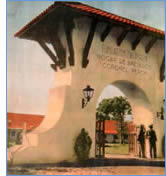 On October 17, 1948, Evita inaugurated a Senior Citizens' Home in Burzaco, Province of Buenos Aires. Three years ago to the day, the descamisados had filled the Plaza de Mayo, demanding that Colonel Perón be released from military custody. On that day, Evita had contracted a debt with the workers and the downtrodden who had obtained Perón's freedom; every new hospital, school, housing development her Fundación offered to the workers and the poor was, in her eyes, simply a partial payment of that debt. On October 17, 1948, Evita inaugurated a Senior Citizens' Home in Burzaco, Province of Buenos Aires. Three years ago to the day, the descamisados had filled the Plaza de Mayo, demanding that Colonel Perón be released from military custody. On that day, Evita had contracted a debt with the workers and the downtrodden who had obtained Perón's freedom; every new hospital, school, housing development her Fundación offered to the workers and the poor was, in her eyes, simply a partial payment of that debt.
The "Hogar Colonel Perón" covered almost eighty acres of rolling hills covered with over one hundred kinds of trees. The eucalyptus, oak, pine, cedar trees offered shade and protection. The stately ombú, native to Argentina, offered a place for the seniors to sip mate, a bitter herbal tea especially dear to gauchos who had worked the fields or herded cattle on the pampas.
The Home consisted of six pavilions in the California Mission style typical of the Fundación's architecture:
1. Offices, Social Services, Reception, Large Dining Room, Kitchen, Medical and Dental Consulting Rooms
2.&3. Residents' rooms, Bathrooms, Small "Family Rooms" where residents could meet to play chess or checkers, listen to music, etc.
4. Clothing, Linens, Washers, Dryers, Ironing, Sewing, Factory
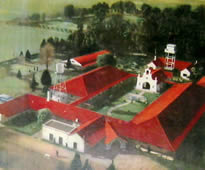 5. Large Meeting Room for socializing, cinema; Library, Artisans' Workshops (weaving, printing, making brooms, brushes, baskets) 5. Large Meeting Room for socializing, cinema; Library, Artisans' Workshops (weaving, printing, making brooms, brushes, baskets)
6. Sisters of Charity Residence
How did the Fundación incorporate the Senior Citizens' Rights into the lives of the 200 residents of the Colonel Perón Home?
1. The right to assistance: if the family could not or would not protect the senior citizen, then the State would do so, directly or indirectly; the Fundación Eva Perón offered the 200 residents every type of assistance needed.
2. The right to housing: residents slept in comfortable bedrooms, each with four beds, four night tables, four lamps, four chairs, four bedside rugs, closets, chintz curtains, shades, a chandelier. They had free run of the grounds of their home, with its flower gardens, pool, countryside.
3. The right to food: Four meals a day were served in the pleasant dining room: breakfast, lunch, tea and dinner. The tables settings were sturdy and of good quality. Fresh flowers adorned each table. Residents sat where and with whom they wished, and servers were attentive to all their requests. Special meals were served to those whose health required it. The menu was typically Argentine, with puchero (a stew of meat and vegetables), steak, pastas, fruit and pastry; much of the produce was grown on the farm.
4. The right to clothing: There were no uniforms in Evita's establisments. The seniors wore clothing of their choice, depending on to their activities at the moment: suits, blazers and ties; jeans or gaucho pants; pullovers, jackets or coats; leather shoes or alpargatas (espadrilles); pyjamas, bathrobes and slippers at night.
5. The right to health care: Social service workers worked on site; doctors and dentists gave regular check-ups in their consulting rooms. A small ten bed ward was available for short term care and the home's ambulance took serious cases to a hospital. Nurses were on call twenty-four hours and two caregivers were in each pavillion throughout the night.
6. The right to spiritual care: Social workers watched over the residents and provided counselling; priests and religious offered spriritual support; religious services were offered on Sundays and holy days. Nurses and employees were respectful, supportive and caring.
7. The right to entertainment: A van was available for excursions; the residents could listen to music, sing, play the piano, dance, exercise. Films were shown on a regular basis. The library contained over 1,500 volumnes. Small "family rooms" between the bedrooms were popular gathering places for games of chess, checkers or cards, especially in the evening. The fragrance of honeysuckle, roses, and flowers from the gardens, the soothing sound of water falling from the fountain, the shade of the trees, all drew the residents outdoors for walks and chats.
8. The right to work: about eighty percent of the residents worked. Everyone who worked received a salary which could be spent, saved, or invested. Residents chose their work, and they could teach their métier to others or learn a new job. A model farm, ecologically managed, contained horses, cows, goats, sheep, pigs, chickens, turkeys. The residents were the principal caregivers; they milked cows, herded flocks, fed poultry; they helped cultivate the land, planting and harvesting crops. Some residents worked in a printshop. Artisans made brooms, brushes, mops; weavers had their own workshop where they produced stockings and rugs; tailors worked at sewing or repairing clothes. Residents volunteered as librarians, musicians, or choir directors. A former engineer was in charge of the electricity for the home.
9. The right to tranquility: Residents were free to establish their own routine: work, walk, talk, enjoy the gardens and the surrounding countryside. All their needs were met: they received companionship, good food, clothing, entertainment. Nothing perturbed the peaceful environment.
10. The right to respect: all residents were called "Grandfather," a term of respect in Latin countries. When their caregivers addressed them affectionately as "Abuelo", they were made to feel part of a family. No one raised a voice to scold them. Evita came often to visit them, talk to them, pat them on the shoulder, encourage them. She must have wished that old Mr. "Buen Día" had been one of the residents.
By 1950, 2350 seniors lived in the Homes built by the Fundación Eva Perón. When the military overthrew Peron's constitutionally elected government in 1955, three Homes for Seniors under construction(in Santa Fé, Tucumán and Córdoba) were left unfinished. After seeing the use the military gave to the Home in Burzaco, Alfredo Palacios, a Socialist who had supported the military coup d'etat, commented, ... the first thing we are doing is taking away the roof that Eva Perón put over their heads... ."
Bibliography:
- Fundación Eva Perón: Un Sueño Hecho Realidad. Presidencia de la Nación, Secretaría de Prensa y Difusión. Buenos Aires. No date.
-
La Organización Social y los Derechos de la Ancianidad. Presidencia de la Nación, Secretaría de Informes. Buenos Aires, 1953.
-
"Los Derechos de la Ancianidad." Mucho Gusto June 1950:44. Ferioli, Néstor. La Fundación Eva Perón. Vol. 1. Buenos Aires: Centro Editor de América Latina, 1990.
-
Biblioteca del Museo Evita, Buenos Aires. |
 |
 ©
By Dolane Larson ©
By Dolane Larson |
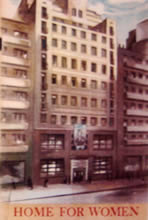 On December 30, 1949, two days before the beginning of 1950, the year dedicated to General San Martín, the Fundación Eva Perón inaugurated The "General San Martín Home for Women Employees" (Hogar de la Empleada General San Martín). Named in honor of the hero of Argentina's independence, located just a few blocks from the Plaza de Mayo on the wide tree-lined Avenida de Mayo number 869, the Home opened its doors to five hundred extremely excited and happy women. On December 30, 1949, two days before the beginning of 1950, the year dedicated to General San Martín, the Fundación Eva Perón inaugurated The "General San Martín Home for Women Employees" (Hogar de la Empleada General San Martín). Named in honor of the hero of Argentina's independence, located just a few blocks from the Plaza de Mayo on the wide tree-lined Avenida de Mayo number 869, the Home opened its doors to five hundred extremely excited and happy women.
The book "El Hogar de la Empleada" sums up the problems faced by young women who make the transition from small town to large city in search of work.
These women who come to Buenos Aires on their own "do not find even a miserable substitute of a home. Life has shown us hundreds of young women who, newspaper in hand, go directly from the train stations or ports to the city in search of work and a place to stay. In the name of progress, how many lives have been frustrated when they have just begun, how many illusions has the city atomized? It seems as though all construction involves destruction. "A young woman employee or worker seems symbolic of the crowded city. Where have we not seen her? Her face appears in millions of offices, in an infinity of hotels, in thousands of factories, behind all the counters. Her young face, marked at times by eyes prematurely aged, is found in shabby boardinghouses where people are out to cheat her, in the doorways of workshops and stores during lunch hours, in sad and solitary ramblings on weekends and holidays."1
Evita had known the loneliness of being separated from friends and family. As a struggling actress, she had lived in boardinghouses far from the city center, less expensive but more dangerous to reach once the theaters closed. She had made the choice between paying her rent or buying food. Her meager salary as an actress was reduced even more by the money she sent to help her family in Junín. One of Evita's friends, Pierina Dealessi, an actress who had her own company, remembers: "Evita was a transparent little thing... . Her hands were always cold and clammy due to her hunger, her sadness... ." 2
As Néstor Ferioli pointed out, "...Evita spoke very little about her life before she met Perón; but one can find her in her works, especially those of the Fundación, and confirm that she constructed her social work based on her own experience as a woman of the people."3
Evita's Home for Women Employees was exactly that: a home. Three conditions were necessary to qualify for admittance as one of the 500 women who lived in the Hogar de la Empleada. The employee could not have any relatives in Buenos Aires; she had to provide a police certificate of good conduct; and, at a time when the minimum wage was $300 pesos, the employee could not earn more than $500. Each employee paid a monthly fee based on her earnings and on the room she lived in (for one, two or three women).4
The Hogar was a self-contained village.
The women's bedrooms occupied nine of the twelve floors. Each suite consisted of a spacious bedroom with wide windows, a bathroom and sitting room. The nine floors was decorated in different styles: French (Louis Quinze), Provençal, Norman French, English Country, Viennese, Contemporary, etc. The brides' floor (for those soon to be married) was done entirely in white.
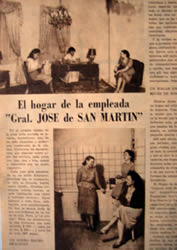 The second floor had a library, a music room and a sewing room. The music room was especially elegant with its lovely curtains, crystal chandeliers, columns, mirrors and objets d'art (porcelain statues, tapestries, a Spanish mantilla thrown over the piano). Most of these objects had been given to Evita by different heads of state during her trip to Europe in 1947. Long before the time of CD's and DVD's, record players, records, and a film projector helped create a cheerful atmosphere. The second floor had a library, a music room and a sewing room. The music room was especially elegant with its lovely curtains, crystal chandeliers, columns, mirrors and objets d'art (porcelain statues, tapestries, a Spanish mantilla thrown over the piano). Most of these objects had been given to Evita by different heads of state during her trip to Europe in 1947. Long before the time of CD's and DVD's, record players, records, and a film projector helped create a cheerful atmosphere.
The sewing room was always crowded with women who wanted to learn to sew, not only to economize by making their own clothes but also to as a means of supplementing their family's finances after they married. Evita never forgot how her own mother had supported her children by sewing; the houses she built were always equipped with sewing machines as were the Hogares de Tránsito (the Temporary Homes where homeless women and children were lodged until work and more permanent living quarters could be found for them). The employees' medical and dental needs were taken care of, absolutely free-of-charge, in consulting rooms on the top floor. A solarium on the terrace, complete with comfortable chaises lounge and hammocks for sunbathing, offered the women a chance to "catch some rays" even in the midst of the big city. Small kitchens on each floor enabled them to prepare a snack, a cup of coffee, tea, or the mate so dear to Argentine hearts. A series of boutiques and small shops made it possible for the women to buy clothes and other necessities without leaving the Home.
Open from 11:00 A.M. to 2:45 P.M. and from 6:30 P.M. to 10:00 P.M., two restaurants made the Home for Women Employees almost self-supporting. One restaurant offered excellent food at very modest prices so that workers who could not go home for lunch would be able to eat a nourishing meal. A union card or employee badge gained them admittance. The other restaurant, open to the general public, also served excellent meals at reasonable prices. The Peronista legislators found it an ideal place to continue their congressional discussions over lunch. This restaurant also offered another extremely busy person who worked nearby a place to relax and enjoy a meal with friends. Often after work, Evita invited her friends and coworkers to dine with her at the Hogar de la Empleada.
In the restaurant of the Hogar de la Empleada, the Peña Eva Perón was born (a peña is simply a meeting of a group of friends who gather to sing or recite poetry). According to Fermín Chávez, a writer and historian who was a frequent participant, the first Peña Eva Perón took place on September 1, 1950. Its origins can be traced back to Evita's afternoons in the Ministerio de Trabajo y Previsión where she attended to the poor. One afternoon José María Castiñeira de Dios, a subsecretary of the Dirección General de Cultura, witnessed a scene which he never forgot. It revealed to him the depth of Evita's understanding that poverty involves more than a lack of material goods. A woman with a hideous sore on her face approached Evita to kiss her. Castiñeira, hearing a doctor comment that the wound could be syphilitic, tried to prevent the woman from coming near Evita. But Evita brushed him aside and let the woman kiss her. Castiñeira was so impressed by this gesture that he wrote a poem in which he compared Evita to the mythological pelican who nourishes its young with its own lifeblood. 5 Asked to read the poem one night, Castiñeira began a tradition in which the Peronista intellectuals shared their poems, thoughts, and, at times, speeches.
Evita was in all the details. In October, 1950, different cultural acts were being planned to commemorate the most important Peronista holiday, October 17. (In October of 1945, fearful of his growing popularity with the workers, the military had arrested Perón. All during the day of October 17, 1945, workers had streamed into Plaza de Mayo, refusing to leave until Perón was finally freed.) Castiñeira had brought the printed program of the week's cultural events to the 1950 Peña to show Evita. The most important date, October 17, when thousands of workers would again fill the Plaza, was listed as a "free day" with no events scheduled. Realizing that the labor unions would perceive this omission as a slight, she pointed it out to Castiñeira. The programs were redone with the Confederación General de Trabajo's massive gathering listed as the day's only event.6
Evita also told Juan Oscar Ponferrada, poet, writer, dramatist and director, "Ponferrada, Shakespeare's The Taming of the Shrew will be performed at the Teatro Cervantes, but as the text is very long ("frondoso"), I want you to work with Fermín Chávez to shorten it." And they did.7
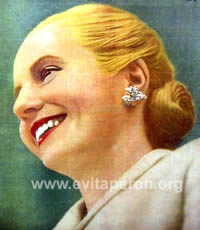 Fermín Chávez points out that the Evita he knew bore no resemblance to the Evita of the "black myth," the "woman with the whip."8 Fermín Chávez points out that the Evita he knew bore no resemblance to the Evita of the "black myth," the "woman with the whip."8
"The Evita I knew was joyful, spontaneous, with no artifice; she impressed you with her vitality [and] extraordinary memory. Her dark eyes, starbright, were what most stood out in her face. During our meals, more than once, we could confirm her extremely rapid natural intelligence and her common sense which left us speechless." During these dinners with her friends and co-workers, Evita could relax, laugh, and be herself. "I cherish in my heart," she wrote, "the pleasant memory of these meetings... ."9
By September of 1950, Evita had less than two years to live and the Golden Age of Peronism was drawing to its close. In 1955, the military staged a coup d'etat which ended Perón's presidency and sent him into exile. As with all the Fundación's works, the Hogar de la Empleada was taken over by the military and put to other uses. In an auction held behind closed doors, the "milicos" and their wives bid on the valuable objects with which Evita had adorned the Hogar. 10
The brochure printed in 1950 to explain the purpose of the Hogar de la Empleada spoke of the human cost involved in human progress: "It seems that all construction involves destruction."
Evita built; those who came after her destroyed. More than fifty-five years after Evita's death, most of the hospitals in use in Argentina today were built during the time of the Fundación Eva Perón.11
El Hogar de la Empleada. [Buenos Aires, Argentina]: Servicio Internacional Publicaciones Argentinas, n.d.
Dujovne Ortiz, Alicia. Eva Perón:A Biography. New York:Saint Martin's Press, 1995. p.40.
Ferioli, Néstor. La Fundación Eva Perón. Vol.1. Buenos Aires: Centro Editor de América Latina, 1990. p.150.
"El Hogar de la Empleada." Mucho Gusto September 1950:47.p.22
Navarro, Marysa. Evita. Buenos Aires: Edhasa, 2005. p.271.
Chávez, Férmin. Eva Perón Sin Mitos. Buenos Aires: Ediciones Theoría, 1996. p. 128.
Eva Perón http://usarios.lycos.es./evaperon3
Chávez., p. 129.
ibid., p. 130.
Ferioli, op.cit., p. 107.
"What is shameful for the military and the politicians who came after Perón is that the majority of the hospitals which were built in the Province of Buenos Aires and in the rest of the country are from that epoch [of the Fundación]." O'Donnel, Pacho, José García Hamilton and Felipe Pigna. Historia Confidencial. Buenos Aires: Planeta, 2006. p. 232. |
|
